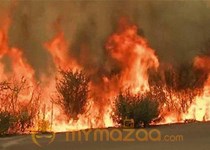A fast-moving wildfire has burned at least two homes and is threatening dozens more in a crowded Northern California neighborhood, as officials elsewhere in the state hope cooler temperatures will help in the fight against a blaze near Yosemite National Park.
A fire department dispatcher in Fairfield, about 40 miles northeast of San Francisco, says two houses on Marigold Drive near Interstate 80 are engulfed in flames and nearby homes are being evacuated. The local fire department is getting help from the California Department of Forestry and Fire Protection.
Meanwhile, crews battling the massive wildfire near Yosemite are anticipating the temperatures and higher humidity this week may allow them to gain an upper hand in containing it.
The Rim Fire -- which is is threatening thousands of structures and historic giant sequoias -- remained 20 percent contained Tuesday.
The fire had ravaged 288 square miles by Tuesday night, the biggest in the Sierra's recorded history and one of the largest on record in California. Nearly 3,700 firefighters are currently battling the blaze, which is also a record.
As flames lapped at the edge of the main reservoir that supplies San Francisco, fears that the inferno could disrupt water or power to the city diminished. On Tuesday the fire moved into the watershed, which increases the chances of sediment runoff this winter.
"It looks great out there. No concerns," Glen Stratton, an operations section chief on the blaze, said of the Hetch Hetchy Reservoir.
Crews remained confident Tuesday that they could protect hydroelectric transmission lines and other utility facilities at the reservoir, the chief source of San Francisco's famously pure drinking water.
"I don't foresee any problems," Stratton said.
Utility officials monitored the basin's clarity and used a massive new $4.6 billion gravity-operated pipeline system to move water quickly to reservoirs closer to the city.
So far the ash that has been raining onto the reservoir has not sunk as far as the intake valves, which are about halfway down the 300-foot O'Shaughnessy Dam. Utility officials said the ash is non-toxic but that the city will begin filtering water for customers if problems are detected.
Power generation there was shut down last week so firefighters would not be imperiled by live wires. San Francisco is buying replacement power from other sources to run City Hall and municipal buildings.
Weather conditions forecast for Wednesday may bring challenges in the morning as heavy smoke settles low to the ground, limiting visibility, but higher humidity was expected in the afternoon which could help dampen the flames, said Matt Mehle, a National Weather Service meteorologist assigned to the fire.
California fire spokesman Daniel Berlant also said crews are expecting cooler temperatures and higher humidity throughout the week.
The last time fire ravages the northernmost stretch of Yosemite was 17 years ago.
Park officials cleared brush and set sprinklers on two groves of giant sequoias that were less than 10 miles away from the fire's front lines, said park spokesman Scott Gediman. While sequoias have a chemical in their bark to help them resist fire, they can be damaged when flames move through slowly with such intense heat.
Lee Bentley, a 73-year-old firefighter told Fox40.com that crews in Tuolumne County have used two DC-10 jets to fight the fire for four days.
“It was like a bomb went off, exploded,” Bentley told the station. “When the inversion lifted, the fog coming from the smoke, when it lifted, this fire exploded and it’s been running away ever since."
The fire has swept through steep Sierra Nevada river canyons and stands of thick oak and pine, closing in on Tuolumne City and other mountain communities. It has confounded ground crews with its 300-foot walls of flame and the way it has jumped from treetop to treetop.
Crews spent Monday bulldozing firebreaks to protect Tuolumne City, several miles from the fire's edge.
Stratton said they would continue working to burn vegetation in the fire's path to slow its march toward town. He said that while the community remains in harm's way, "I'm pretty optimistic."
Meanwhile, biologists with the Forest Service are studying the effect on wildlife. Much of the area that has burned is part of the state's winter-range deer habitat. Biologist Crispin Holland said most of the large deer herds would still be well above the fire danger.
Biologists discovered stranded Western pond turtles on national forest land near the edge of Yosemite. Their marshy meadow had burned, and the surviving creatures were huddled in the middle of the expanse in what little water remained.
"We're hoping to deliver some water to those turtles," Holland said. "We might also drag some brush in to give them cover."
Wildlife officials were also trying to monitor at least four bald eagle nests in the fire-stricken area.
While it has put a stop to some backcountry hiking, the fire has not threatened the Yosemite Valley, where such sights as the Half Dome and El Capitan rock formations and Yosemite Falls draw throngs of tourists. Most of the park remained open to visitors.
Rugged terrain, strong winds and bone-dry conditions have hampered firefighters' efforts to contain the blaze, which began Aug. 17. The cause has not been determined.







